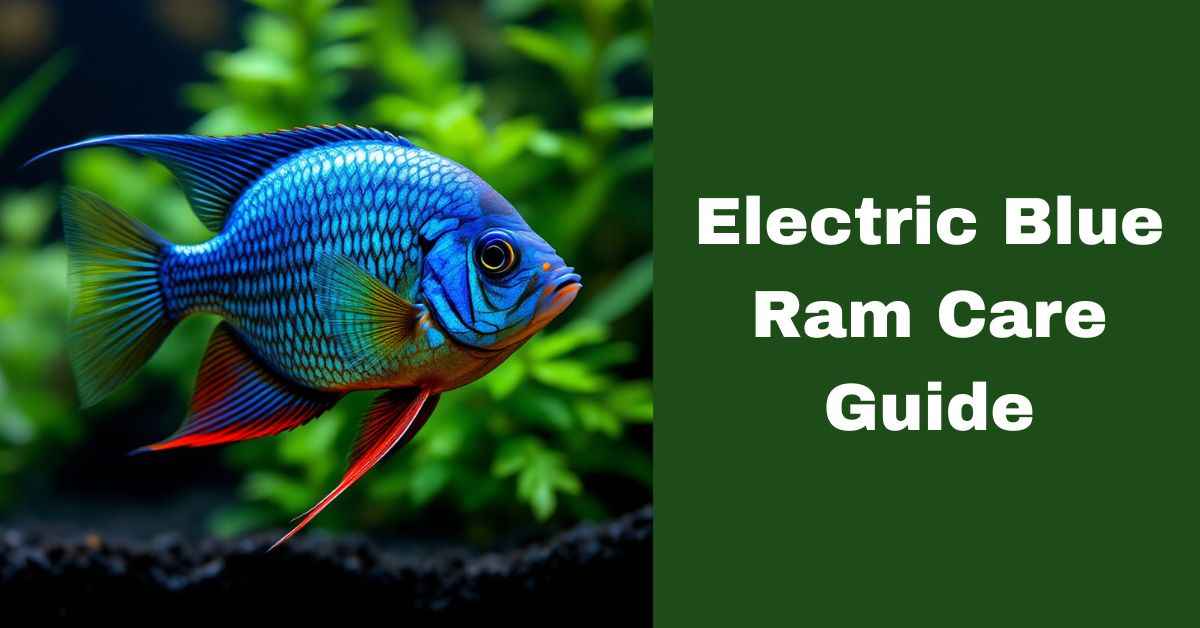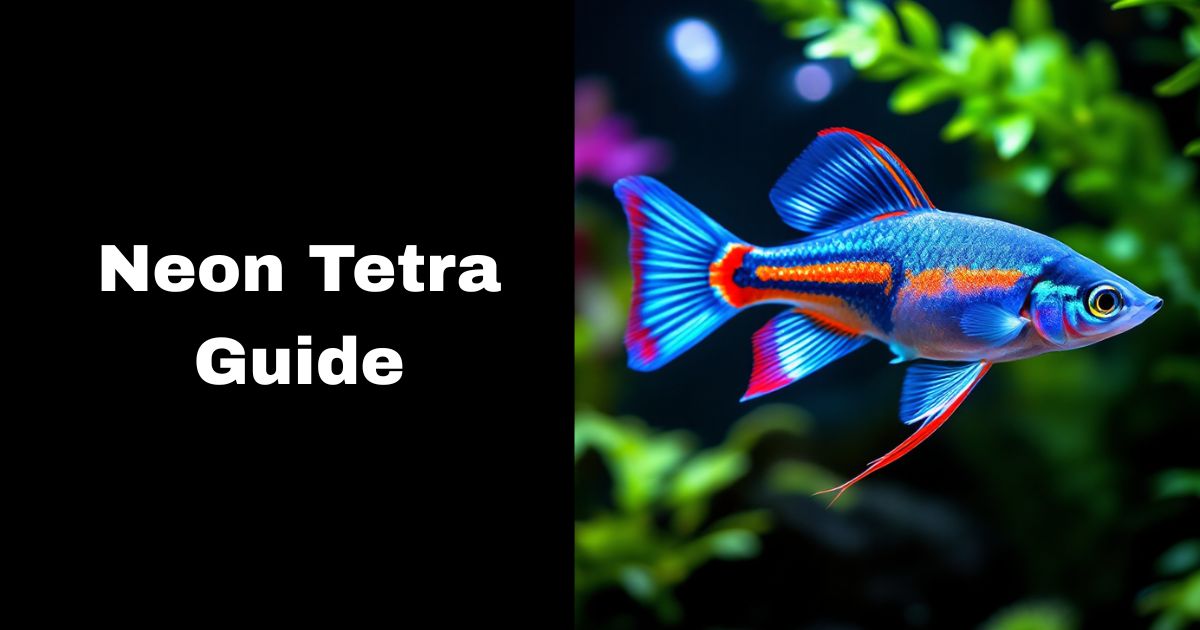The Electric Blue Ram is a stunning freshwater fish that has captivated aquarists worldwide. Known for its vibrant blue coloration, peaceful temperament, and manageable size, this dwarf cichlid is a favorite for both beginners and experienced fishkeepers. However, caring for these beauties requires more than just admiration—they thrive in specific conditions and need proper attention to their diet, tank setup, and health.
In this comprehensive guide, we’ll explore everything you need to know about the Electric Blue Ram. From understanding its natural habitat to setting up the perfect tank, feeding it the right diet, and troubleshooting common health issues, this article covers it all. Whether you’re a seasoned aquarist or just starting out, you’ll find practical tips and insights to ensure your Electric Blue Rams live a happy, healthy life.
What is an Electric Blue Ram?
The Electric Blue Ram (Mikrogeophagus ramirezi) is a freshwater fish species belonging to the cichlid family. This fish is a selectively bred variant of the German Blue Ram, known for its dazzling electric blue scales. Its compact size—typically growing to about 2-3 inches—makes it ideal for smaller aquariums.
What sets the Electric Blue Ram apart is its peaceful demeanor. Unlike many other cichlids, which can be aggressive, this species is calm and thrives in community tanks with compatible tank mates. Its shimmering blue body, accented by hints of yellow and red, makes it a true showstopper in any aquarium.
Origin and Natural Habitat
The Electric Blue Ram originates from the warm, slow-moving rivers and streams of South America, particularly in Venezuela and Colombia. In the wild, these fish inhabit shallow waters with sandy substrates, dense vegetation, and plenty of hiding spots.
Their natural environment is characterized by warm temperatures (around 78-85°F), slightly acidic water (pH 5.0-6.5), and low water hardness. These conditions are crucial to replicate in captivity to ensure their well-being.
Electric Blue Ram Facts & Overview
| Feature | Description |
|---|---|
| Scientific Name | Mikrogeophagus ramirezi |
| Common Names | Electric Blue Ram, German Blue Ram, Butterfly Cichlid |
| Family | Cichlidae |
| Origin | South America (Venezuela and Columbia) |
| Lifespan | 3–4 years |
| Size | Up to 2–3 inches (5–7.5 cm) |
| Diet | Omnivorous (high-quality flakes, pellets, live or frozen foods) |
| Common Colors | Bright electric blue with yellow, black, and red markings |
| Care Level | Moderate |
| Temperament | Peaceful, but territorial during spawning |
| Lighting | Moderate lighting |
| Habitat | Freshwater |
| Minimum Tank Size | 20 gallons (75 liters) |
| Tank Setup | Soft substrate, live plants, driftwood, rocks for hiding spaces |
| Tank Placement | Mid to lower level of the tank |
| Temperature Range | 78–85°F (25–29°C) |
| pH Range | 5.5–7.0 |
| Salinity | Freshwater (no salinity required) |
| Alkalinity | 1.0–5.0 dKH |
| Propagation | Egg layers; lay eggs on flat surfaces; parents guard eggs and fry |
Tank Setup for Electric Blue Rams
Creating the ideal environment for your Electric Blue Ram is crucial for their health and happiness. These fish are sensitive to their surroundings, so replicating their natural habitat as closely as possible will help them thrive.
Ideal Tank Size
When it comes to tank size, bigger is always better for Electric Blue Rams. While a minimum tank size of 20 gallons is recommended for a pair, a larger tank—30 gallons or more—provides more space for swimming and reduces territorial disputes.
These fish are small, but they’re active swimmers and enjoy exploring their environment. A spacious tank also allows you to add compatible tank mates without overcrowding, which is essential for maintaining a peaceful community.
Water Parameters and Quality
Water quality is one of the most critical factors for keeping Electric Blue Rams healthy. These fish are native to warm, slightly acidic waters, so you’ll need to maintain the following parameters:
- Temperature: 78-85°F (ideal for tropical fish)
- pH Level: 5.0-7.0 (slightly acidic to neutral)
- Water Hardness: 3-8 dGH (soft water)
Consistency is key! Sudden changes in water conditions can stress your Electric Blue Rams, making them more susceptible to diseases. Regular water testing and weekly water changes (about 25-30%) will help maintain stable conditions.
Substrate and Decorations

To mimic the natural habitat of Mikrogeophagus ramirezi, choose a soft, sandy substrate. Sand is gentle on their delicate fins and allows them to exhibit natural behaviors like digging.
Adding live plants, driftwood, and rocks not only enhances the tank’s aesthetics but also provides hiding spots and reduces stress. Popular plant choices include Java Fern, Anubias, and Amazon Swords. These plants thrive in the same water conditions as Electric Blue Rams and create a lush, natural environment.
Filtration and Aeration
A good filtration system is essential for maintaining water quality. Opt for a filter that provides gentle water flow, as Blue Rams prefer calm waters. Canister filters or sponge filters are excellent choices.
While these fish don’t require strong aeration, ensuring proper oxygen levels is still important. Adding an air stone or adjusting the filter’s outflow can help maintain oxygenation without creating too much turbulence.
Diet and Feeding Habits
Feeding your Electric Blue Ram a balanced diet is essential for their vibrant coloration and overall health. These fish are omnivores, meaning they eat both plant-based and protein-rich foods. Let’s dive into their dietary needs and feeding habits.
What Do Electric Blue Rams Eat in the Wild?
In their natural habitat, Electric Blue Rams feed on small invertebrates, insects, and plant matter. Their diet is diverse, which helps them get all the nutrients they need. Replicating this variety in captivity is key to keeping them healthy and happy.
Best Foods for Electric Blue Rams in Captivity
In an aquarium setting, Electric Blue Rams thrive on a mix of high-quality commercial foods and fresh treats. Here are some excellent options:
- Pellets and Flakes: Choose high-quality, nutrient-rich pellets or flakes designed for cichlids.
- Live Foods: Bloodworms, brine shrimp, and daphnia are excellent protein sources that mimic their natural diet.
- Frozen Foods: If live foods aren’t available, frozen options like mysis shrimp or tubifex worms are great alternatives.
- Vegetable-Based Foods: Blanched spinach, zucchini, or algae wafers can provide essential plant-based nutrients.
Offering a varied diet ensures your Electric Blue Rams get all the vitamins and minerals they need to maintain their vibrant colors and energy levels.
Feeding Schedule and Tips
Feed your Electric Blue Rams small amounts 2-3 times a day. They have small stomachs, so overfeeding can lead to health issues and poor water quality.
Here are some tips to keep in mind:
- Remove uneaten food after 5-10 minutes to prevent it from decaying in the tank.
- Rotate between different food types to keep their diet interesting and balanced.
- Observe their behavior during feeding—healthy Electric Blue Rams are active and eager to eat.
By following these feeding guidelines, you’ll ensure your Electric Blue Rams stay healthy, vibrant, and full of life.
Behavior and Tank Mates for Electric Blue Rams
The Electric Blue Ram is not only admired for its stunning appearance but also its fascinating behavior and compatibility with other fish. Understanding their temperament and choosing the right tank mates is essential for maintaining a peaceful and thriving aquarium.
Understanding Electric Blue Ram Behavior
Electric Blue Rams are known for their calm and peaceful nature, which makes them a great addition to community tanks. They are social fish that enjoy interacting with their environment and other tank inhabitants. However, they can exhibit territorial behavior, especially during breeding periods.
These fish are also highly sensitive to stress, which can be triggered by poor water quality, overcrowding, or aggressive tank mates. Signs of stress include hiding, loss of color, or reduced activity.
Providing plenty of hiding spots and maintaining stable water conditions can help keep your Electric Blue Rams happy and stress-free.
Best Tank Mates for Electric Blue Rams

When selecting tank mates for your Electric Blue Ram, it’s important to choose species that share similar water requirements and have a peaceful temperament. Here are some excellent options:
- Tetras: Neon Tetras, Cardinal Tetras, and Rummy Nose Tetras are small, non-aggressive fish that thrive in similar water conditions.
- Corydoras Catfish: These bottom-dwelling fish are peaceful and won’t compete with Electric Blue Rams for territory.
- Dwarf Gouramis: Their calm nature makes them a suitable companion for the Electric Blue Rams.
- Otocinclus Catfish: These algae-eating fish are small and non-intrusive, making them ideal tank mates.
Avoid keeping Electric Blue Rams with aggressive or overly active species like large cichlids or barbs, as they can stress or outcompete the Rams for food and space.
Breeding Behavior and Pairing
Breeding Electric Blue Rams can be a rewarding experience, but it requires careful preparation. These fish form monogamous pairs and exhibit fascinating courtship behaviors. To encourage breeding, ensure the following:
- Maintain optimal water conditions with slightly warmer temperatures (around 82-85°F).
- Provide flat surfaces like smooth rocks or broad leaves for spawning.
- Feed the pair a protein-rich diet, including live or frozen foods, to condition them for breeding.
During courtship, the pair will clean a chosen spawning site and display vibrant colors. After laying eggs, the parents will guard and care for the fry, making them excellent caregivers.
Common Health Issues and How to Prevent Them
Like any aquarium fish, Electric Blue Rams are susceptible to certain health issues. However, with proper care and attention, many of these problems can be prevented. Let’s explore the most common health concerns and how to keep your Rams in top shape.
Common Diseases in Electric Blue Rams
Some of the most common health issues affecting Electric Blue Rams include:
- Ich (White Spot Disease): A parasitic infection that causes white spots on the fish’s body and fins.
- Fin Rot: A bacterial infection that leads to frayed or discolored fins.
- Swim Bladder Disorder: A condition that affects the fish’s ability to swim properly, often caused by overfeeding or poor water quality.
These issues are often linked to stress, poor water conditions, or an unbalanced diet.
Preventative Measures for Healthy Electric Blue Rams
Prevention is always better than cure when it comes to fish health. Here are some tips to keep your Electric Blue Rams healthy:
- Quarantine New Fish: Always quarantine new fish for at least two weeks before introducing them to your main tank. This helps prevent the spread of diseases.
- Maintain Water Quality: Regular water changes, proper filtration, and consistent water parameters are essential for preventing stress and illness.
- Provide a Balanced Diet: A varied diet with high-quality foods ensures your fish get the nutrients they need to stay healthy.
Recognizing Signs of Illness
Early detection is key to treating health issues in Electric Blue Rams. Watch for the following signs of illness:
- Loss of appetite
- Faded or dull coloration
- Erratic swimming or difficulty swimming
- Visible spots, lesions, or frayed fins
If you notice any of these symptoms, isolate the affected fish and consult a veterinarian or aquatic specialist for treatment options.
Related Articles:
FAQs
How Long Do Electric Blue Rams Live?
On average, Electric Blue Rams live for about 2-3 years in captivity. However, with excellent care, including stable water conditions, a balanced diet, and a stress-free environment, they can sometimes live up to 4 years. Their lifespan largely depends on the quality of care they receive, so consistency is key.
Are Electric Blue Rams Hard to Care For?
While Electric Blue Rams are not the easiest fish to care for, they’re manageable with the right knowledge and preparation. They require stable water parameters, a peaceful tank environment, and a varied diet. Beginners can successfully care for them if they’re willing to put in the effort to maintain their tank properly.
Can Electric Blue Rams Live with Shrimp?
Yes, Electric Blue Rams can live with shrimp, but it depends on the type of shrimp. Larger shrimp species, like Amano shrimp, are generally safe tank mates. However, smaller shrimp, such as Cherry shrimp, may be seen as food, especially if the Rams are hungry. If you want to keep shrimp with your Rams, ensure there are plenty of hiding spots for the shrimp to retreat to.
How Can I Tell if My Electric Blue Ram is Male or Female?
Male and female Electric Blue Rams have subtle differences in appearance. Males are typically larger and have more elongated dorsal fins, while females are smaller and may display a pinkish hue on their bellies, especially during breeding periods. Observing their behavior can also help—males are often more territorial.
Why is My Electric Blue Ram Losing Color?
Color loss in Electric Blue Rams is often a sign of stress or poor health. Common causes include unstable water conditions, poor diet, or aggressive tank mates. To restore their vibrant coloration, ensure the water parameters are consistent, feed them a high-quality diet, and provide a peaceful environment.
Conclusion
The Electric Blue Ram is a true gem in the world of freshwater aquariums. With their dazzling blue coloration, peaceful temperament, and fascinating behavior, they bring life and beauty to any tank. While they do require a bit of extra care and attention, the rewards of keeping these fish are well worth the effort.
By providing the right tank setup, maintaining stable water conditions, and offering a varied diet, you can ensure your Electric Blue Rams thrive in their environment. Whether you’re a beginner or an experienced aquarist, these fish are a joy to care for and observe.
So, if you’re looking to add a splash of color and personality to your aquarium, the Electric Blue Ram is an excellent choice. With proper care, these fish will not only survive but flourish, becoming the centerpiece of your aquatic world.




